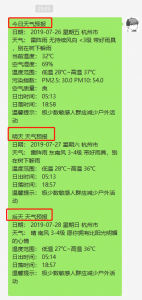使用python获取天气接口给指定微信好友发天气预报
先看下效果图:

用到的模块:
- PyMySQL
- requests
- threading
- wxpy
要实现上面的示例,首先是有两大块地方
- 获取天气信息
- 通过微信将天气信息发送出去
而获取天气信息又包括几个小的需要注意的地方
- 获取天气信息
- 获取天气信息的接口
- 获取天气信息的城市
- 获取所在城市的城市码
假如我们给多个人发送天气情况,这几个人来自不同的城市,那么我们不可能每次都要输入城市名,然后查找城市码,然后再访问接口,获取天气情况,这样会非常的麻烦,所以我们需要考虑将城市名跟城市码一一对应起来,说到一一对应,首先想到的数据结构便是字典,所以我们可以将这些信息存入一个字典里,然后持久化到一个文件中,这样便方便很多
首先我们获取最新的 city 表,这个表是一个 list 类型,大体格式如下:
[
{
"id": 1,
"pid": 0,
"city_code": "101010100",
"city_name": "北京",
"post_code": "100000",
"area_code": "010",
"ctime": "2019-07-11 17:30:06"
},
{
"id": 2,
"pid": 0,
"city_code": "",
"city_name": "安徽",
"post_code": null,
"area_code": null,
"ctime": null
}
]
我们就简单的粘贴复制,放到一个空的列表中,如下所示,将所有的城市信息放到列表 citycode 中
citycode = [
{
"id": 1,
"pid": 0,
"city_code": "101010100",
"city_name": "北京",
"post_code": "100000",
"area_code": "010",
"ctime": "2019-07-11 17:30:06"
},
...
...
...
...
...
...
{
"id": 2,
"pid": 0,
"city_code": "None",
"city_name": "安徽",
"post_code": "null",
"area_code": "null",
"ctime": "null"
}
]
cityinfo = {}
#将城市名和城市代码写入json文件中
with open("city_for_code.json","w",encoding="utf-8") as f:
for i in citycode:
name = i["city_name"]
code = i["city_code"]
cityinfo[name] = code
f.write(str(cityinfo))
#测试是否能读取
with open("city_for_code.json","r+",encoding="utf-8") as file:
data_dst = file.readlines()
d = eval(data_dst[0])
然后就是一顿处理,只把我们所需的 city_name 和 city_code 这俩字段取出即可,随后写入文件中。如果读取的话就按照上面方法去读取,需要注意的是,使用 open()方法读取文件,得到的内容是一个列表,我们需要通过 eval()方法转化成 dict 类型。
这是把 city_name 和 city_code 放到一个文件中的方法,另外我们也可以放到数据库中,这里以 MySQL 为例,安装 PyMySQL 模块
import pymysql
db_parames = {
"host": "localhost",
"user": "root",
"password": "123456",
"database": "city_code_info"
}
#连接数据库
conn = pymysql.connect(**db_parames)
#创建游标对象,增删改查都在游标上进行
cursor = conn.cursor()
#表存在,就删除
cursor.execute("DROP TABLE IF EXISTS city_code")
#建表语句
create_table_sql = """CREATE TABLE `city_code` (
`city_name` varchar(20) DEFAULT NULL,
`city_code` varchar(25) DEFAULT NULL
) ENGINE=InnoDB DEFAULT CHARSET=utf8mb4;
"""
#建表
cursor.execute(create_table_sql)
#插入数据
with open("city_for_code.json","r+",encoding="utf-8") as f:
origin_data = f.readlines()
current_data = eval(origin_data[0]) #读取的内容是一个列表,且只包含一个元素
#print(current_data.get("北京","Not Exists."))
for name, code in current_data.items():
sql = """INSERT INTO city_code(city_name, city_code) VALUES ("%s", "%s")""" % (name, code)
try:
cursor.execute(sql)
except:
conn.rollback()
conn.commit()
conn.close()
执行这个 python 程序就可以将文件中的城市名跟城市码存到库中,当然我们也可以直接获取到城市名和城市码,然后跳过文件持久化这一步,直接把这两个字段取出存进去,但是考虑着代码要多练多写,就多此一举了一下。
下面是输入城市名就能得到城市码的代码块:
import pymysql
def get_city_code(city_name):
db_parames = {
"host": "localhost",
"user": "root",
"password": "123456",
"database": "city_code_info"
}
#连接数据库
conn = pymysql.connect(**db_parames)
#创建游标对象,增删改查都在游标上进行
cursor = conn.cursor()
#创建查询语句
select_sql = "SELECT * FROM city_code where city_name="%s""%(city_name)
try:
cursor.execute(select_sql)
result = cursor.fetchall()
for row in result:
city_code = row[1]
return city_code
except:
return "Error: unable fetch data!"
然后是根据输入的城市码来获取天气情况:
import requests
def get_weather(city_name,get_date_time=3):
city_code = get_city_code(city_name)
url = "http://t.weather.sojson.com/api/weather/city/%s"%(city_code)
header = {
"user-agent": "Mozilla/5.0 (Windows NT 10.0; WOW64) AppleWebKit/537.36 (KHTML, like Gecko) Chrome/74.0.3729.169 Safari/537.36"
}
response = requests.get(url,header)
response.encoding = "utf-8"
weather = response.json()
day = {1: "明天", 2: "后天", 3: "大后天"}
weather_lst = []
for num in range(get_date_time):
City = weather["cityInfo"]["city"]
Weatherganmao = weather["data"]["ganmao"]
Weatherquality = weather["data"]["quality"]
Weathershidu = weather["data"]["shidu"]
Weatherwendu = weather["data"]["wendu"]
Weatherpm25 = str(weather["data"]["pm25"])
Weatherpm10 = str(weather["data"]["pm10"])
Dateymd = weather["data"]["forecast"][num]["ymd"]
Dateweek = weather["data"]["forecast"][num]["week"]
Sunrise = weather["data"]["forecast"][num]["sunrise"]
Sunset = weather["data"]["forecast"][num]["sunset"]
Windfx = weather["data"]["forecast"][num]["fx"]
Windf1 = weather["data"]["forecast"][num]["fl"]
Weathertype = weather["data"]["forecast"][num]["type"]
Weathernotice = weather["data"]["forecast"][num]["notice"]
Weatherhigh = weather["data"]["forecast"][num]["high"]
Weatherlow = weather["data"]["forecast"][num]["low"]
if num == 0:
result = "今日天气预报" + "
"
+ "日期: " + Dateymd + " " + Dateweek + " " + City + "
"
+ "天气: " + Weathertype + " " + Windfx + " " + Windf1 + " " + Weathernotice + "
"
+ "当前温度: " + Weatherwendu + "℃" + "
"
+ "空气湿度: " + Weathershidu + "
"
+ "温度范围: " + Weatherlow + "" + "~" + "" + Weatherhigh + "
"
+ "污染指数: " + "PM2.5: " + Weatherpm25 + " " + "PM10: " + Weatherpm10 + "
"
+ "空气质量: " + Weatherquality + "
"
+ "日出时间: " + Sunrise + "
"
+ "日落时间: " + Sunset + "
"
+ "温馨提示: " + Weatherganmao
else:
which_day = day.get(num,"超出范围")
result = "
" + which_day + " " + "天气预报" + "
"
+ "日期: " + Dateymd + " " + Dateweek + " " + City + "
"
+ "天气: " + Weathertype + " " + Windfx + " " + Windf1 + " " + Weathernotice + "
"
+ "温度范围: " + Weatherlow + "" + "~" + "" + Weatherhigh + "
"
+ "日出时间: " + Sunrise + "
"
+ "日落时间: " + Sunset + "
"
+ "温馨提示: " + Weatherganmao
weather_lst.append(result)
weather_str = "" #因为默认要输出三天的天气情况,所以我们需要创建一个空字符串,然后每迭代一次,就将天气情况拼接到空字符串中。
for msg in weather_lst:
weather_str += msg + "
"
return weather_str
下面是发送微信消息
from wxpy import *
def send_wx(city_name, who):
bot = Bot(cache_path=True)
#bot = Bot(console_qr=2, cache_path="botoo.pkl")
my_friend = bot.friends().search(who)[0]
msg = get_weather(city_name)
try:
my_friend.send(msg)
except:
my_friend = bot.friends().search("fei")[0]
my_friend.send(u"发送失败")
然后我们还需要写一个定时器,每隔一段时间便要发送一次
from threading import Timer
def auto_send():
city_name = "设置要发送的城市"
friend_list = ["要发送的人"]
for who in friend_list:
send_wx(city_name,who)
global timer
timer = Timer(1,auto_send)
timer.start()
最后执行程序
if __name__ == "__main__":
timer = Timer(1,auto_send)
timer.start()
欢迎各位朋友关注我的公众号,来一起学习进步哦
本文由博客群发一文多发等运营工具平台 OpenWrite 发布

![使用python获取天气接口给指定微信好友发天气预报[Python基础]](https://www.zixueka.com/wp-content/uploads/2023/10/1696934306-77996ce1aaa4174.jpg)
